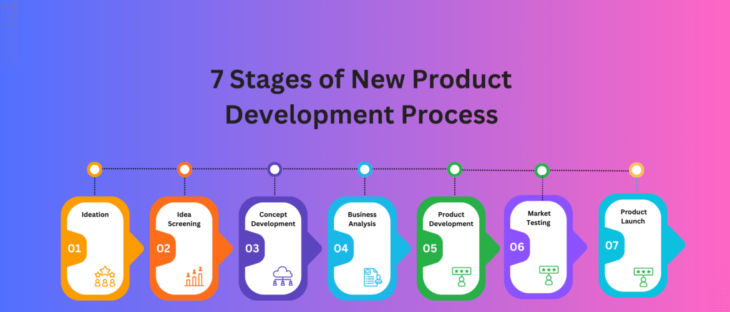
- March 23 2024
- admin
Launching a new product can be an exciting yet challenging process. Most successful products go through a structured development process from initial concept to full launch. Understanding the key stages of new product development can help companies manage the risks and maximize the rewards of innovation. In this post, we’ll explore the 7 main stages of the new product development process for bringing a new product to market.
Stage 1: Ideation
The new product development process starts with idea generation. This phase focuses on identifying opportunities, solving problems, and brainstorming. Companies can gather ideas from employees, customers, partners, or wider market research. Effective ideation requires an open culture that encourages sharing novel concepts. Brainstorming sessions, design sprints, and innovation challenges can stimulate creative thinking. The goal is to produce a large number of ideas from which the most promising can be selected for further exploration.
Key activities in the ideation stage of the new product development process include:
- Internal crowdsourcing (gathering ideas from employees)
- Customer interviews and surveys to identify unmet needs
- Competitive analysis to see what others are doing
- Market research for trends and segmentation data
- Focus groups and prototyping to test concepts
- Visualization using techniques such as design thinking
The ideation process allows companies to tap into internal and external sources of inspiration and creativity.
Stage 2: Idea Screening
Once ideas have been generated, they need to be evaluated and prioritized. This preliminary assessment examines each concept’s feasibility and market potential.
Key steps in the preliminary assessment stage of new product development include:
- Evaluating technical feasibility and capabilities
- Estimating development timelines and costs
- Reviewing intellectual property issues
- Assessing market size, competition, and growth potential
- Determining strategic alignment with company goals
- Identifying critical uncertainties and risks
- Prioritizing concepts based on potential value.
This process helps narrow down the ideas to a focused set of product opportunities. The most promising opportunities can then pass to the concept development stage of the new product development process.
Stage 3: Concept Development
Now the idea starts taking shape as a concrete product concept. This involves detailed market research and analysis to determine product features, pricing, positioning, and sales projections. Companies will evaluate different concept variants and finalize an optimal product definition.
Important concept development activities in the new product development process include:
- Competitive benchmarking
- Customer needs analysis through interviews and focus groups
- Segmentation analysis
- Value proposition development
- Building out product specifications
- Modeling sales volume, growth, and profitability
- Defining minimum success criteria
The goal is to synthesize customer insights with business analysis to design the best product concept before development begins. This provides a clear strategic direction.
Stage 4: Business Analysis
With a solid concept in place, next comes the business analysis and justification stage of the new product development process. This involves building out a comprehensive business case to estimate costs, and project returns, and secure internal stakeholder buy-in.
Key business case elements include:
- Detailed market size estimates and demand forecasting
- Revenue modeling based on pricing and sales volume
- Cost analysis for production, distribution, marketing, etc.
- Profitability projections
- Timeline estimates
- Organizational resource requirements
- Investment payback period
- Risk assessment
- Recommendations and conclusions
Developing a convincing business case is vital for securing the required resources and executive support to advance a new product through the stages of new product development.
Stage 5: Product Development
This stage takes the product from concept to reality. The idea is turned into a physical product through design, engineering, prototyping, and testing. Development may involve creating new technologies, capital investments, and establishing manufacturing capabilities.
Key product development steps in the new product development process:
- Industrial design to optimize form and function
- Engineering design and prototyping
- Pilot production processes
- Product testing, validation, and refinement
- Securing facilities, equipment, and staff
- Developing documentation for manufacturing
Thorough development eliminates glitches and delivers a compelling product for launch.
Stage 6: Market Testing
Before the full launch, the product will undergo market testing. This provides real-world validation with a small target audience. Companies may do limited rollouts in select markets or offer samples to potential customers.
Market testing allows companies to:
- Gather feedback on product performance and quality
- Test assumptions about pricing, packaging, and promotion
- Identify any flaws or final improvements needed
- Project service and support requirements
- Refine launch and distribution plans
This stage minimizes surprises and provides critical insights from end-users.
Stage 7: Product Launch
The final stage is full product launch and commercialization. This requires coordinated efforts across departments to ramp up production, develop marketing campaigns, and expand distribution.
Key commercialization activities in the new product development process:
- Launching integrated marketing campaigns
- Building sales channels and partnerships
- Scaling up manufacturing and operations
- Establishing sales and customer service capabilities
- Monitoring performance post-launch
- Managing ongoing product improvements and updates
The launch stage converts the hard work of development into tangible business results.
In summary, bringing a product to market involves a series of structured stages – from ideation to full commercialization. Understanding this new product development process allows companies to manage new product projects effectively. The 7 key stages include ideation, preliminary assessment, concept development, business analysis, product development, market testing, and commercialization. Each step builds on the last to transform ideas into successful products. By managing risks and leveraging insights at each phase, companies can smooth the path from initial ideas to profits.
For companies looking to develop innovative new products, partnering with an experienced design and engineering firm can be invaluable. Upcore Technologies has extensive expertise in taking products from concept to commercial launch. Their full-service capabilities in research, design, prototyping, testing, and manufacturing can shepherd a product through the entire new product development process. With a methodical approach focused on feasibility, quality, and speed-to-market, Upcore helps turn promising ideas into reality. Their deep technical skills paired with keen business acumen enable efficient, lower-risk new product launches.
So for any company seeking to leverage new ideas and innovations, remember the structured 7-stage new product development process. Focus on assessing feasibility, analyzing the business case, thorough design and testing, and coordinated commercialization. And consider leveraging capable partners like Upcore Technologies to tap into specialized expertise. With the right process and resources, companies can smoothly navigate the journey from ideas to profits and successfully deliver new value to the market.


